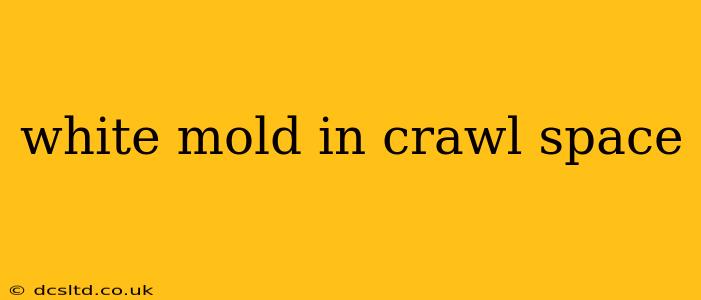Discovering white mold in your crawl space can be alarming, but understanding its causes and how to address it is crucial for maintaining a healthy home environment. This comprehensive guide will delve into the intricacies of white mold in crawl spaces, providing you with the knowledge and strategies to effectively tackle this common issue.
What is White Mold in a Crawl Space?
White mold, often appearing as fuzzy or powdery patches, isn't a single type of mold but a general term encompassing numerous species. Common culprits include Serpula lacrymans (dry rot) and various species of Fusarium, Penicillium, and Aspergillus. While some white molds are relatively harmless, others can cause allergic reactions or, in rare cases, more serious health problems. Crucially, identifying the specific type of mold requires professional testing. Don't attempt to handle extensive mold infestations yourself; always consult with a qualified mold remediation specialist.
What Causes White Mold Growth in Crawl Spaces?
Several factors contribute to white mold proliferation in crawl spaces:
- Moisture: This is the primary driver. Leaks from pipes, faulty drainage, high humidity, and poor ventilation all create ideal conditions for mold growth. Even condensation on cold surfaces can provide enough moisture.
- Poor Ventilation: Stagnant air allows moisture to accumulate, fostering mold growth. Crawl spaces need adequate ventilation to circulate air and reduce humidity.
- Organic Material: Wood, insulation, cardboard, and other organic materials provide a food source for mold. Decaying materials exacerbate the problem.
- Temperature: While mold can grow in various temperatures, warmer, humid conditions accelerate its growth.
H2: How Do I Identify White Mold in My Crawl Space?
Identifying white mold accurately requires careful observation. Look for:
- Fuzzy or powdery patches: These are the most common visual indicators. The texture can vary depending on the mold species.
- Musty odor: Mold often emits a distinct musty smell. If you detect this smell, investigate potential sources of mold growth.
- Discoloration of materials: Mold can stain wood, insulation, and other materials.
Important Note: If you suspect mold growth, avoid direct contact. Wear protective gear like gloves, a mask, and eye protection before investigating.
H2: Is White Mold in a Crawl Space Dangerous?
The danger posed by white mold depends on the specific species and the extent of the infestation. Some white molds are relatively innocuous, causing only minor allergic reactions in sensitive individuals. Others can produce mycotoxins, harmful substances that can trigger more severe respiratory problems or other health issues. If you experience symptoms like coughing, sneezing, watery eyes, or skin irritation after entering your crawl space, consult a doctor immediately.
H2: How Can I Prevent White Mold in My Crawl Space?
Prevention is key. Here are effective strategies:
- Improve ventilation: Install vents or a dehumidifier to control humidity levels.
- Address moisture problems: Repair leaks promptly, improve drainage around your foundation, and ensure proper grading to divert water away from your home.
- Remove organic materials: Keep the crawl space clean and free of debris, wood scraps, and other organic materials.
- Maintain a dry environment: Regularly monitor humidity levels and address any signs of moisture immediately.
- Regular inspections: Periodically inspect your crawl space for signs of mold growth. Early detection allows for timely intervention and prevents the problem from escalating.
H2: How Do I Get Rid of White Mold in My Crawl Space?
Addressing a white mold infestation can be complex, and often requires professional intervention, especially for larger infestations. Small, isolated patches may be addressed with a diluted bleach solution (always follow product instructions carefully), but be aware that bleach may not kill all types of mold. For larger infestations or if you’re unsure about the type of mold present, contact a qualified mold remediation professional. They will perform testing, safely remove the affected materials, and implement appropriate remediation measures.
This guide provides a foundational understanding of white mold in crawl spaces. Remember, preventing mold growth is always preferable to remediation. By taking proactive steps and addressing moisture issues promptly, you can significantly reduce the risk of mold developing in your crawl space and maintain a healthier home environment. Always prioritize safety and consult professionals when necessary.
